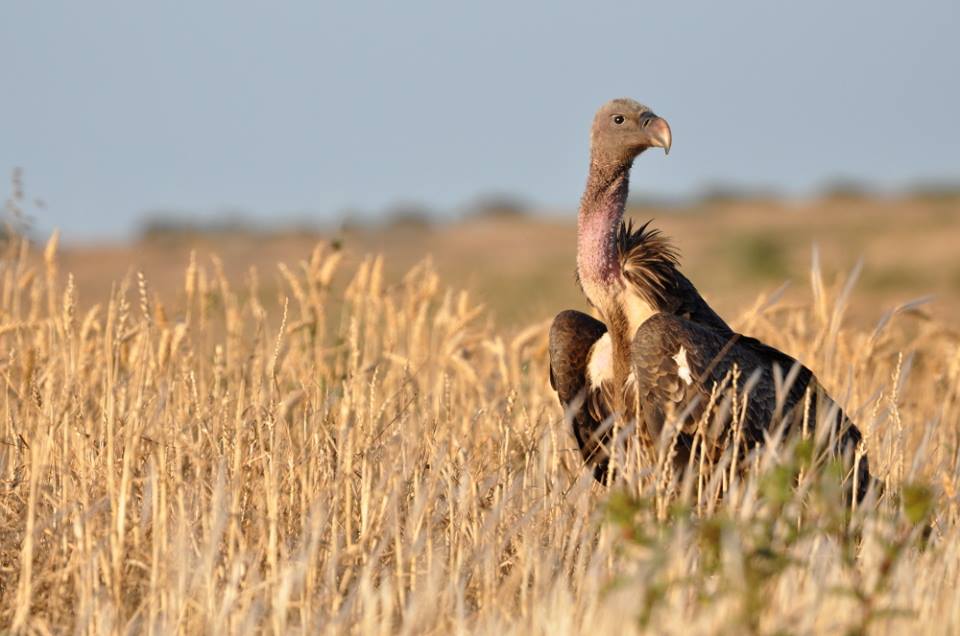Historically, five vulture species had existed in Northwest Africa (the Maghreb), namely: Egyptian Vulture, Griffon Vulture, Bearded Vulture, Cinereous Vulture and Lappet-faced Vulture. Of these, only the first three species still breeding in the region, while the last two species are already extirpated (although the Cinereous Vulture is a regular wintering and migrant in Morocco).
In addition to these ‘native breeding vultures’, three species are rare accidental visitors to the region from sub-Saharan Africa: Hooded Vulture, White-backed Vulture and Rüppell’s Vulture (although the latter species is not so rare, but should be regarded as a regular migrant now).
Of the breeding species, the Egyptian Vulture is the most widespread species in the region. The Griffon Vulture is probably doing well in Algeria than in Morocco and Tunisia. Finally, the Bearded Vulture is the rarest breeding vulture species in the region.
The total number of vulture species in the list of each country is as follows: 8 species for Morocco, 6 species for Algeria and 4 species for Tunisia.
Two types of data were used to compile this list. First, I consulted the historical data in the ‘bird checklists’ of the three countries (Isenmann & Moali 2000, Isenmann et al. 2005, Thévenot et al. 2003). For the recent information, I used the scarce published data, plus unpublished data from Morocco and Algeria (our own data + data communicated by Algerian colleagues).
Here is the full list of the 8 vulture species of the region with a brief comment on their regional status. (The global conservation status of each vulture species is mentioned at the beginning).
Bearded Vulture (Gypaetus barbatus)
The species is classified as Near-threatened globally, but it is Critically Endangered regionally. The species has disappeared from Tunisia. In Algeria, it has not been observed since decades, but two recent observations give hopes that the species still survive in the country. In Morocco, the breeding population is small and endangered. Read:
Egyptian Vulture (Neophron percnopterus)
Endangered globally and regionally. Formerly, the species was widely distributed from Morocco to Tunisia, but it disappeared from many regions over the years. Nevertheless, it still breeds in many other regions in the three countries (Middle Atlas in Morocco, many areas in Algeria,…etc.). Read:
Hooded Vulture (Necrosyrtes monachus)
Critically Endangered. The species is a rare visitor to southern Morocco from its breeding areas in West Africa. Only two birds in 1955. Update: an immature bird was observed at Jbel Moussa in April and May 2023.
White-backed Vulture (Gyps africanus)
Critically Endangered. The species is a very rare visitor to Morocco. The first observation of this vulture species in Morocco and North Africa was in May 2014. Since then, more birds have been observed in Morocco, especially at Jbel Moussa (exp: four birds in May and June 2024). However, not all vultures initially identified as “White-backed Vulture” are actually this species. Read:
- First record of White-backed Vulture for Morocco and North Africa.
- Movements of four White-backed Vultures GPS-tagged at Jbel Moussa.
Rüppell’s Vulture (Gyps rueppelli)
Critically Endangered. Nowadays, the species is a regular migrant in Morocco. First records were noted at the end of the 1990s, and the number of birds seen annually has increased during the last years (especially since 2014 when more or less regular monitoring of raptor migration at Jbel Moussa started). It’s a rare visitor to Algeria with only one known record: a bird captured by the Forestry brigade at Siar, a locality in the commune of Chechar located some 60 km south of Khenchela on 24 April 2006 (Chenchouni et al. (2007). Read (some examples):
- Rüppell’s Vultures at Aousserd (2011).
- Spectacle: 7 Rüppell’s Vultures in 2 days in northern Morocco (2014).
- Rüppell’s Vulture wing-tagged at Jbel Moussa (2016).
Griffon Vulture (Gyps fulvus)
The species is classified as Least Concern globally, but it’s Critically Endangered regionally (especially in Morocco and Tunisia). Considered extinct in Tunisia as a breeding species (but most likely still hanging-on in the NW of the country near the border with Algeria). There are no recent observations in Morocco, but in any case it’s extremely rare as a breeding species or already extinct. In Algeria, the species is apparently doing well at some sites. As a migrant and wintering visitor, thousands of birds cross annually the Strait of Gibraltar to Morocco and Africa in general.
Cinereous Vulture (Aegypius monachus)
Near-threatened. It disappeared as a breeder species from Algeria and Morocco. Historically, the species was not known to breed in Tunisia. Currently, a few birds – probably some tens annually – visit Morocco and reach as far south as West Africa. Read (some examples):
- 4 Cinereous Vultures crossing the Strait of Gibraltar in one day (2017).
- First record of Cinereous Vulture for Mauritania (2017)
- First record of Cinereous Vulture for The Gambia (2018)
Lappet-faced Vulture (Torgos tracheliotos)
Endangered. The species has disappeared as a breeding species from the region since several decades ago. Probably some birds still visit the southern fringes of the region.
References:
Amezian, M. & El Khamlichi, R. 2016. Significant population of Egyptian Vulture Neophron percnopterus found in Morocco. Ostrich 87: 73-76.
Amezian, M. El Khamlichi, R. & El Haoua, M. K. 2014. First record of White-backed Vulture for Morocco and North Africa. MaghrebOrnitho. Published 25 May 2014.
Chenchouni, H., Righi, Y. & Si Bachir, A. 2007. Mise à jour et statut écologique de l’avifaune des Aurès. Acte des Journées Internationales sur la Zoologie Agricole et Forestière. Institut National Agronomique, El Harrach, Alger: 08-10 avril 2007.
Djardini, L., Ouar, D. & Fellous, A. 2014. Le Gypaète barbu dans le ciel du Parc National de Theniet El Had. Atlantica 1: 3-4.
Isenmann, P., & Moali, A. 2000. Oiseaux d’Algérie / Birds of Algeria. SEOF, Paris.
Isenmann, P., Gaultier, T., El Hili, A., Azafzaf, H., Dlensi, H. & Smart, M. 2005. Oiseaux de Tunisie / Birds of Tunisia. SEOF, Paris.
Thévenot, M., Vernon, R. & Bergier, P. 2003. The birds of Morocco. BOU Checklist No. 20. BOU, Tring.
